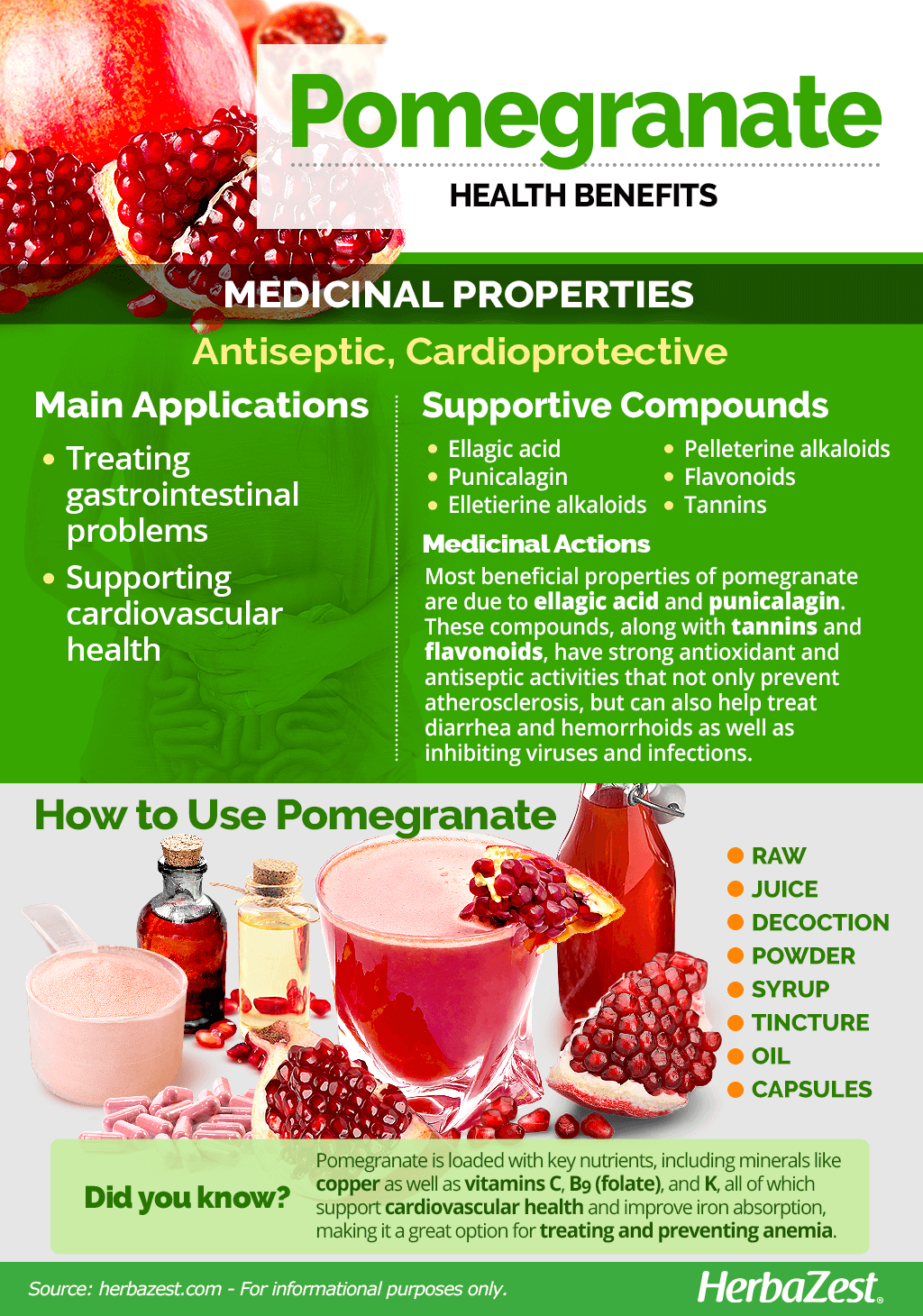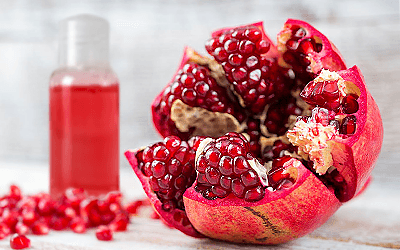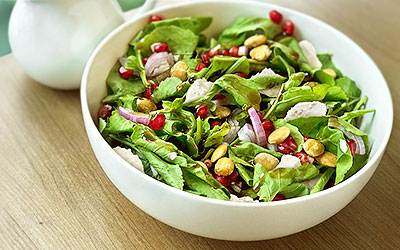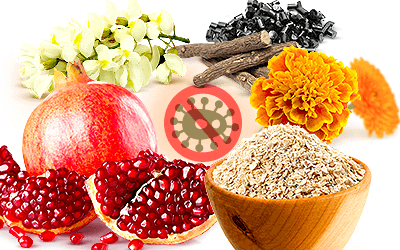Pomegranate has been valued for its nutritional and medicinal benefits for thousands of years. The fruit, seeds, peel, bark, and leaves of the plant have been extensively used in the ancient Ayurveda system of medicine to treat a wide variety of health conditions, from diarrhea and intestinal worms to cardiovascular issues and hemorrhoids. Modern research has corroborated pomegranate's strong antioxidant activity, making it a popular "super fruit," with a number of medicinal applications.
Pomegranate Medicinal Properties
- Medicinal action Antiseptic, Cardioprotective
- Key constituents Ellagic acid, punicalagin, pelletierine alkaloids
- Ways to use Capsules, Decoctions, Hot infusions/tisanes, Food, Juiced, Tincture, Powder, Syrup, Essential oil
- Medicinal rating (3) Reasonably useful plant
- Safety ranking Use with caution
Health Benefits of Pomegranate
Pomegranates possess strong antioxidant and antiseptic properties, used by herbalists for millennia to treat a wide variety of health conditions. The most popular medicinal applications of pomegranate are:
Treating gastrointestinal problems. Due to its antiseptic, anti-inflammatory, and astringent properties, pomegranate haven been traditionally used for alleviating diarrhea, dysentery, cholera, upset stomach, and hemorrhoids, as well as for eliminating intestinal parasites.
Supporting cardiovascular health. Pomegranates have also been shown to help prevent and treat cardiovascular conditions, such as high blood pressure, high cholesterol, heart disease, and atherosclerosis.
Additional medicinal uses of pomegranate include preventing an treating diabetes, as well as infections such as herpes simplex, flu, and gum disease.
How It Works
The two compounds largely responsible for pomegranate's antioxidant activity are ellagic acid and punicalagin. Flavonoids also play an important role in pomegranate's antioxidant activity because of their effect in eliminating free radicals.
Pomegranate's strong antioxidant and antiseptic properties are due to the combined action of tannins, flavonoids, and alkaloids. Together, these compounds work to protect cells from oxidative damage. The tannins in pomegranate not only help stop diarrhea and alleviate hemorrhoids, but also also inhibit the replication of herpes simplex virus.
Pelletierine alkaloids found in pomegranate bark are responsible for its antiseptic qualities.
Antiseptic properties can be found in cardamom and eucalyptus, whereas olive and tomato boost cardiovascular health.
Pomegranate Side Effects
Dietary consumption of pomegranate has been deemed generally safe. However, the fruit can cause allergic reactions in sensitive people. Symptoms include skin rash, hives, and bronchospasms.
Cautions
Pomegranate can negatively interact with certain medications, such as over-the-counter painkillers and anti-depressive drugs, reducing their pharmacological action and potentiating their side effects.
Since pomegranate has the ability of lower blood pressure, people taking anti-hypertensive medication should avoid consuming this fruit in any form.
Pomegranate is also a natural blood thinner, and those about to undergo surgical procedures should about its consumption, since it inhibits coagulation. It is recommended to seek medical advice before consuming pomegranate in medicinal doses.
Nutritional Facts of Pomegranate
Pomegranate is known as a "super food" because of its nutrient-rich qualities. It is loaded with vitamins A, E, and C, all of which have antioxidant actions and work together to support cardiovascular health, as well as for improving iron absorption, which makes pomegranate fruit a great option to treat and prevent anemia.
Pomegranate juice has been shown to contain more antioxidants than most fruit juices, red wine, or green tea.
How to Consume Pomegranate
- Edible parts Fruit, Seed
- Edible uses Beverage
- Taste Sweet
Due to their nutritional and medicinal benefits, pomegranate fruits are widely consumed in salads and desserts, as well as processed into jams, syrups, wine, and candies. However, its healing properties are more concentrated in remedial and supplemental forms.
Natural Forms
Raw. The antioxidant benefits of pomegranate can be obtained in its natural, fresh form.
Juice. The popularity of pomegranate juice has spiked in recent years, since it has been shown to reduce free radicals in cells.
Decoction. Boiling pomegranate rinds an leaves for few minutes will allow for a more concentrated form of the herb, which can be drank on daily basis to keep in check cholesterol levels and get rid of intestinal worms.
Powder. The pomegrate fruit is dehydrated and processed into a fine powder that concentrates its medicinal benefits and can be added to beverages and smoothies.
Herbal Remedies & Supplements
Syrup. This is a highly concentrated form that can be taken orally to control hypertension.
Tincture. The crushed seeds of pomegrate, as well as its fresh juice can be added to an alcohol solution and be kept aside for few weeks until the properties of the herb have been extracted. Few drops of this tincture are diluted in water for medicinal effects.
Oil. Extracted from the seeds, pomegranate oil is a potent antioxidant and anti-inflammatory agent. It is used externally to moisturize hair, skin, and nails, as well as for treating acne and eczema.
Capsules. Softgel capsules are also available for medicinal use, and they offer the advantage of a convenient, daily doses, in order to manage blood pressure and weight.
Growing
- Life cycle Perennial
- Harvested parts Roots, Seeds, Leaves, Fruit
- Light requirements Full sun
- Soil Light (sandy)
- Soil pH 6.1 – 6.5 (Slightly acidic), 6.6 – 7.3 (Neutral)
- Planting time Right after last frost
Pomegranate is a perennial plant that grows best in tropical and temperate climates with hot, dry summers and cool winters.
Growing Guidelines
Pomegranate prefers well-drained, sandy soil, with a neutral or slightly acidic pH.
The plant needs plenty of sunlight, but moderated watering for best results.
Because of its size and wide root systems, it is best to plant pomegranate in rows placed 22 feet (7 m) apart.
They plant can withstand considerable drought, but for the best fruit yield, it is recommended to water it once a week.
It is best to plant in early winter or late spring after the last frost.
Pomegranates have similar shelf-lives as apples, so they are best stored at a temperature of 32 - 41°F (0 - 5°C) after harvest.
Additional Information
- Other uses Cosmetics
Plant Biology
Pomegranate is a deciduous shrub or tree that can grow up to 20 feet (6 m) in height. Pomegranate plants are characterized by their bright orange-red flowers and large, fleshy, red fruit. The fruit is encased in a leathery rind with a prominent calyx attached.
Classification
Pomegranate, or Punica granatum, is a member of the Punicaceae family. Pomegranate is one of the only two species in its genus, Punica, which is the sole genus in the Punicaceae family.
Varieties and Cultivars of Pomegranate
Despite its long history of cultivation and use, no distinct subspecies of Punica granatum have been identified by botanists. However, a "dwarf" variety (Punica granatum var. nana) exists, and it's used mainly as an ornamental plant or a bonsai specimen. In addition, approximately 500 cultivars exist worldwide.
Historical Information
It is thought that pharaoh Tuthmosis introduced pomegranate from Asia to Egypt as early as 1500 BCE. Pomegranates also played a role in Greek mythology: they were called the "fruit of the dead," referring to the story of Hades tricking Persephone into eating its seeds in order to keep her as his wife.
Aside from its nutritional and medicinal healing properties, the pomegranate rind was also supposedly used by the Ancient Romans as a leather substitute. However, its medicinal uses were forgotten after the fall of the Roman Empire, and it wasn't until the 19th century that herbalists began using pomegranate to get rid of tapeworms again, and it became recognized as a popular remedy.
Economic Data
Pomegranates have been a popular fruit ever since their discovery, but their popularity has spiked recently due to their high antioxidant content and other nutritional value. The leaders in pomegranate production and cultivation are the United States, specifically California, followed by Turkey. In California, an estimated 20,500 tons of pomegranate fruit are produced each year.
Other Uses
Gardening. Some pomegranate cultivars have ornamental value, particularly the dwarf varieties.
Personal care. Pomegranate oil is also used in the cosmetic industry, in creams, massage oils, masques, and toners.
Sources
- China Journal of Chinese Materia Medica, [Antiviral activity of tannin from the pericarp of Punica granatum L. against genital Herpes virus in vitro], 1995
- Journal of Pharmacognosy and Phytochemistry, Medicinal Uses of Punica granatum and Its Health Benefits
- Encyclopedia of Herbal Medicine, pp. 258-259
- MedlinePlus Herbs and Supplements, Pomegranate
- Medicinal Plants of the World, p. 263
- University of Maryland Medical Center, Pomegranate










